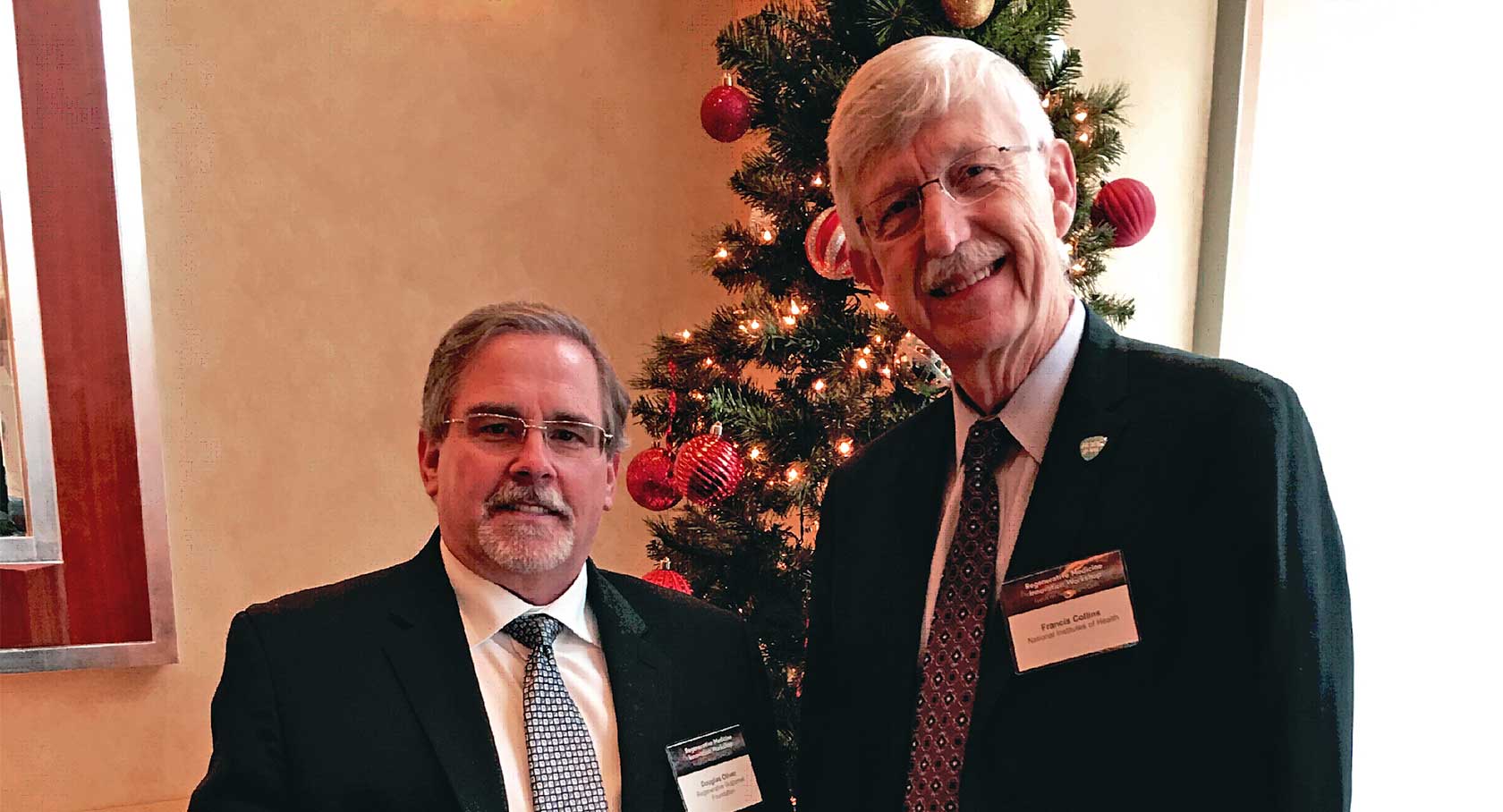By Marlene Cimons – November 6, 2021 at 12:00 p.m. EDT – Link to Article
Douglas Jantz, 57, a retired middle school teacher from Houston, has been playing tennis since he was 9. He is serious about his game, so he was worried when his knees started to hurt. Eventually, he was diagnosed with osteoarthritis (OA).
Tennis is my favorite sport, so I was very upset,” he says. “I was really afraid I would have to give it up.”
A cortisone shot and physical therapy didn’t help, and the pain grew worse. Having switched doctors when his insurance changed, his new physician suggested he consider something different: injections with platelet-rich plasma, or PRP, a therapy that uses certain cells, platelets and growth factors from a patient’s own blood to ease pain and mend injured tissues.
After suffering for two years, Jantz readily agreed. “I thought it was definitely worth a try,” he says. Jantz has had several PRP injections in each knee since 2018, and he says they helped. He’s playing tennis again, mostly pain free, and doing other things that he found difficult before. “Today, I feel very good,” he says.
PRP is among several therapies that are part of the growing practice of regenerative medicine, a field that relies on the body’s natural properties to heal itself. While these therapies have been in use for many years, mainstream medicine has been slow in adopting them, in part because studies have shown conflicting results.
Researchers say that these procedures suggest efficacy, and pose little risk, because the material comes from the patient’s own body. But they agree that more standardized studies are needed, especially when it comes to PRP.
There have been at least 80 studies using PRP in the knees with mixed results, depending on the severity of the arthritis and a lack of consistency in composition of the PRP — that is, which blood cells are separated out and used. For this reason, some medical organizations, such as the Arthritis Foundation and the American College of Rheumatology, recommend against it.
All PRP is not the same,” says John Ferrell III, a regenerative sports medicine physician in the D.C. area who uses PRP in his practice and believes in its therapeutic benefits when administered by experienced clinicians. “Also, it seems to work best on mild to moderate OA,” he says.
Insurance companies and Medicare still regard the therapy as experimental and refuse to cover the costs.
Nevertheless, the market for regenerative medicine, including for knee osteoarthritis, has been growing with estimates that it will expand to $39 billion in 2024, up from $13.3 billion in 2019, according to Doctor.com, a company that provides marketing information to medical practices.
In addition to PRP, the knee therapies include the use of micro-fragmented adipose (fat) transfer and bone marrow aspirate. In recent years, clinicians who use them say all three are attractive — and less dangerous — alternatives to widely used steroid injections, which research now suggests not only fail to help patients but actually hasten cartilage loss.
My goal as a knee surgeon is to save knees, so it’s very exciting to see these emerging technologies,” says Nicholas DiNubile, a Philadelphia-area orthopedic surgeon and vice president of the American Academy of Anti-Aging Medicine.
Several years ago, we used to say, in terms of regenerative therapies, that the marketing was ahead of the science,” DiNubile says. “But today, the science is beginning to catch up. There is solid research that they are effective and safe. They don’t regrow cartilage, but they reboot the knee in a way that it behaves better.”
Prathap Jayaram, director of regenerative sports medicine and assistant professor in the department of physical medicine and rehabilitation and orthopedic surgery at the Baylor College of Medicine — and who treated Jantz — calls knee osteoarthritis one of the leading musculoskeletal disabilities of aging.
It causes chronic pain, impaired mobility and functional impairment — being able to get up and go to the bathroom, go down the stairs, walk the dog, and imposes a significant financial burden,” he says. “It’s very common — nearly 80 percent of people older than 55 have X-ray evidence of it. Either you have it, or you know somebody who does.”
More than 32.5 million Americans suffer from osteoarthritis, according to the Centers for Disease Control and Prevention. The disease occurs when cartilage — the tissue that cushions the ends of the bones within the joints — breaks down and wears away, sometimes leaving bones that rub up against each other, often described as “bone on bone.” The knees are among the joints most commonly afflicted, causing stiffness, pain, making it difficult to walk, climb, get in and out of chairs and bathtubs — and, for active older adults, to play sports.
While it doesn’t regrow new cartilage, researchers say that the use of PRP might delay its loss, raising the prospect that patients might be able to avoid knee replacement surgery if they are treated early enough. Jayaram and his colleagues already have shown it works in mice.
There really are no treatments for knee osteoarthritis,” he says. “We have therapies that manage symptoms, but no disease-modifying treatment. In preclinical work, we’ve been able to show that PRP can delay disease progression, laying the foundation for a pilot clinical study in patients.”
For moderate-to-severe cases, clinicians often turn to micro-fragmented adipose tissue transfer or bone marrow. Both involve using fat or marrow taken directly from the patient, then reintroduced after processing into the knees. These procedures are more invasive than PRP — which involves a simple blood draw from a patient’s arm — but can be done in an office setting using a local anesthetic.
I’ve had patients, whose average age was 70, who could have been immediate candidates for total knee replacement, who did well,” after receiving fat injections, says William Murrell, an orthopedic regenerative sports medicine specialist in New York and lead author of a recently published study on the use of adipose tissue in elderly patients with knee osteoarthritis. “Also, the great benefit of using adipose tissue is that we see a significant amount of symptom amelioration for a good amount of time.”
These approaches are all autologous, meaning the patient is both donor and recipient — and not taken from anyone else, which enhances safety — and should not be confused with stem-cell therapies. Stem cells have become controversial in recent years because of false claims and misinformation over social media about unproven therapies, resulting in patient injuries when used by inexperienced practitioners or non-physicians. PRP is a blood product that doesn’t contain stem cells. And, while bone marrow concentrate and micro-fragmented adipose contain a small amount of stem cells, the two aren’t marketed as stem-cell treatments.
Bone marrow aspirate contains growth factors that decrease inflammation and promote healing, while micro-fragmented adipose tissue is marketed for cushioning and support. The Food and Drug Administration regulates them as human cells, tissues, and cellular and tissue-based products. Both are prepared for injection using kits cleared by the FDA, while PRP is processed using a centrifuge, also approved by the agency.
For human cells and tissues, the agency monitors for safety but does not give “approval” for specific uses because that would be regulating the practice of medicine, which it does not have the authority to do. While PRP isn’t “FDA approved” per se, the agency allows it to be legally offered “off-label” in clinics for numerous musculoskeletal conditions.
You can use these products if they meet two criteria, minimal manipulation [meaning the product hasn’t been changed in a way that would turn it into a drug] and homologous use,” Ferrell says. Micro-fragmented adipose tissue and bone marrow aspirate treatments “are minimal manipulation and, as long as the physician is injecting ‘like into like,’ this is homologous use. So, injecting bone marrow into bone or fat into areas that contain fat for the purposes of cushioning, this is homologous use.”
Moreover, “fat grafting is a common medical procedure and has been considered mainstream since the 1990s in plastic surgery,” he adds. “Insurance companies are really the only ones that consider this experimental.”
Numerous studies suggest clinical improvement in knee osteoarthritis using PRP, micro-fragmented adipose tissue transfer and bone marrow aspirate.
Jayaram recently completed a pilot study of PRP injections for knee arthritis in 12 patients in their 50s and 60s, Jantz among them, using novel wearable microchip sensors to measure PRP’s therapeutic effects on function and movement.
Six weeks after treatment, they found significant improvement in pain and “timed up and go,” a test that measures how long it takes someone to rise from a chair, walk about 10 feet, turn around 180 degrees, walk back to the chair and sit down while turning 180 degrees.
PRP is emerging as one of the promising candidates to treat OA that are currently being used in clinical practice,” he says.
Patients with more advanced osteoarthritis benefit more from fat or bone marrow treatments, clinicians say.
Adipose tissue is a signaling device that sends messages to other cells in the area to turn off the inflammation,” Murrell says. “Adipose doesn’t regenerate cartilage, but it turns off the pathways that prompt the breakdown.”
The fat is taken from the abdomen, hips or gluteal region. “Then we do a mechanical separation — it sounds like using a cocktail shaker — that removes oils, red blood cells, but keeps the good fat that we do want,” Ferrell says. “We use about 12 ounces — about a soda can full.”
It usually requires a single shot, and relief — from the cushioning, lubrication and reduced inflammation — can last as long as three years, he says.
With bone marrow aspirate concentrate, the material is extracted from the back of the hip bone — equal to about half a soda can, Ferrell says — which is spun into a concentrated solution to eliminate certain cells, then injected into the knee.
It’s a great anti-inflammatory, and continues to turn off inflammation,” Ferrell says. “It also creates more stabilization in the meniscus and supporting ligaments of the knee. Patients can notice an improvement in their symptoms within one week.”
The costs can range from $3,500 to $10,000 (the latter in expensive areas such as New York or San Francisco) for fat and bone marrow, considerably less for PRP, although insurance often does cover fees for office visits and diagnostics, such as ultrasound exams.
Many patients think it’s worth it “when you look at price of knee replacement at $50,000, which is covered, but there are deductibles and co-pays — which typically cost the patient $4,000 to $6,000 out of pocket — and a much more difficult and painful recovery,” Ferrell says. “We’re trying to redefine orthopedic medicine. We want to give people minimally invasive options before they need definitive invasive surgery.”
Meanwhile, Jantz, whose last PRP injection was nearly a year ago, is playing tennis and has resumed hiking and other past activities.
Going down those hills used to be tough,” he says, remembering his earlier hikes. “I had to crab walk my way down, but now I’m not afraid to do them anymore. I’m also much better sitting, standing and walking, which used to be painful. Now I’m at the gym every day.”




